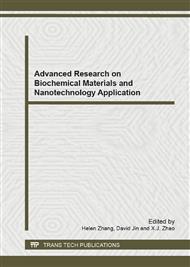p.9
p.13
p.17
p.21
p.25
p.29
p.33
p.37
p.43
The Application of Biological Materials on the Cruciate Ligament Reconstruction of Knee-Joint in Athletic Injury
Abstract:
It is Important content that to make Surface modification and surface modification and Improve the material on the surface of the cell adhesion and promotes cell proliferation to bone tissue engineering scaffolds. The role of osteoblast and support material dependent on the Material surface characteristics, Local shape, surface energy and chemical energy, which Determine how cells adsorbed onto the surface of the material and Localization of cells and cell function behavior. Therefore, the complexity of biomaterials and cell biological material surface interaction determines the biological scaffold materials for surface modification of importance. Ideal surface modification should take into consideration the surface topology, specific identification, hydrophilic and hydrophobic protein adsorption equilibrium, and other aspects of functional new tissues. At present, the most applications in surface modification of materials is type I collagen, future research will be a variety of surface modification of materials for composite materials, which will play complementary roles, as well as gene therapy and the development of nanometer materials, it will become a hot issue in the field of bone tissue engineering.
Info:
Periodical:
Pages:
25-28
Citation:
Online since:
January 2013
Authors:
Price:
Сopyright:
© 2013 Trans Tech Publications Ltd. All Rights Reserved
Share:
Citation:


